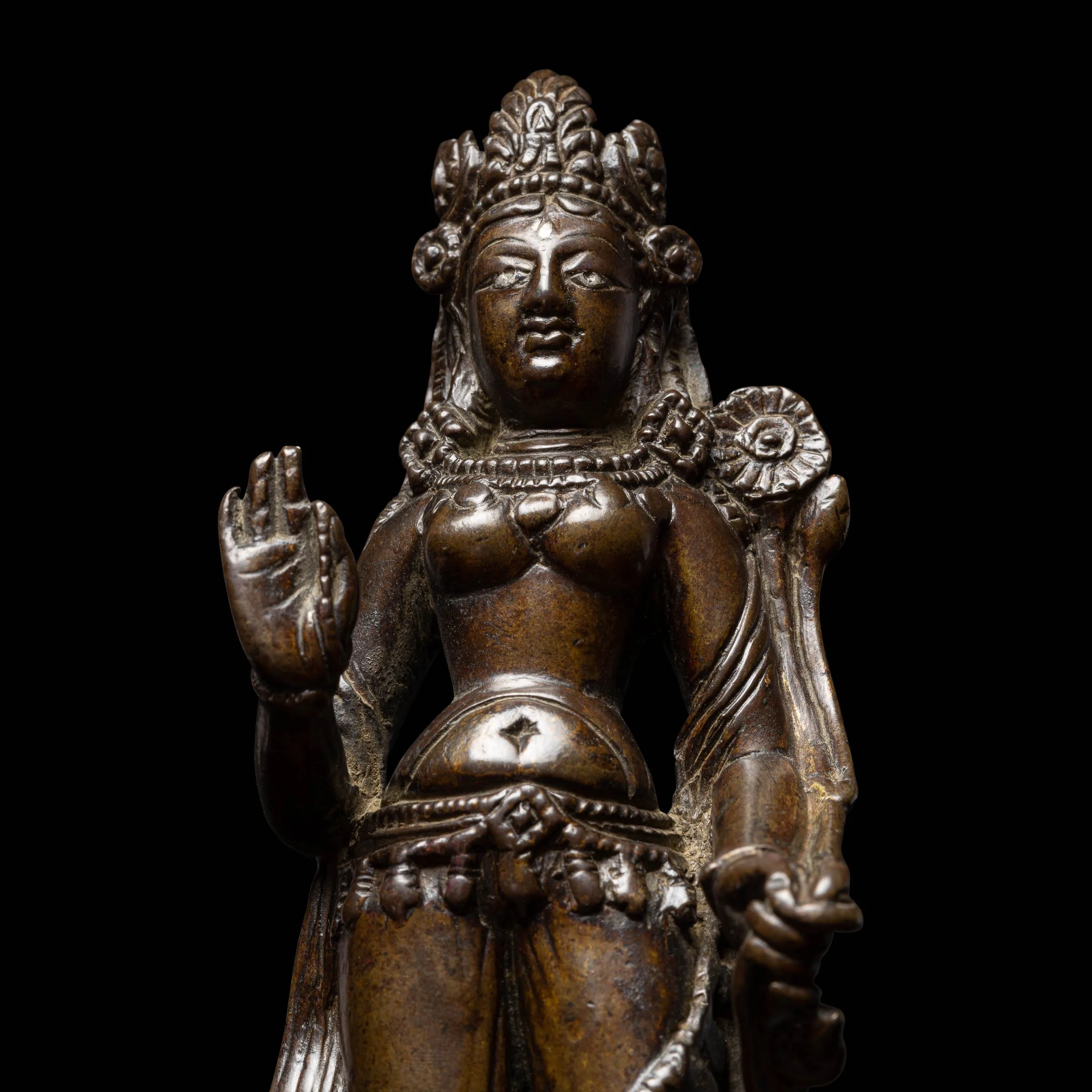tara
The Sanskrit name ‘Tara’ is derived from the Sanskrit word ‘tarika’ which means ‘dilveress’ or ‘savioress.’ She first appears as an attendant to Manjushri in the Manushrimulakalpa and, later, as an enlightened figure in her own right, in the Taramulakalpa which was likely authored sometime in the seventh century. The present figure—a commanding image of the all-knowing goddess Tara—is a product of the valley of Kashmir.
A flourishing center of Buddhist learning, the people of Kashmir were great patrons of Buddhist works of art. Kashmir’s location, bordering northern India, central Asia, and the western Himalayas and its historical shaping under the Gupta and Huna peoples made it a racially and culturally diverse center for the arts. The mid-seventh-century Karkota dynasty and mid-ninth century Utpala dynasty were instrumental in disseminating Buddhist ideas and arts from Kashmir, exporting their cultural products to their neighbors. Expertly inlaid precious metals exemplified by the present figure’s three silver eyes are one of several hallmarks of a perennially exquisite style of metal sculpture born from Kashmir.
Tara’s diaphanous top is hemmed to reveal her cruciform navel in a distinctly Kashmiri fashion, decisively differentiating it from the Gupta aesthetic. Such an attenuated waist, protruding belly, and large hips are common among early images of female deities. For another example of this type, see a four-armed silver-inlaid bronze figure of Tara at the Ashmolean Museum dated to the first half of the ninth century (acc. EA2013.67). Dr. Pal describes a mode of facial representation shared among Kashmiri sculpture of the ninth century (Bronzes of Kashmir, New York, 1975, pl. 47), as characterized by a full face, flat nose, and less elongated eyes than earlier prototypes—qualities shared by the present bronze and the Ashmolean example. The present figure, though, shares the prominent chin of earlier examples such as a Prajnaparamita or Sarasvati which Pal attributed to the seventh century (The Arts of Kashmir, Asia Society: New York, 2007, p. 94, fig. 98).
The present Tara’s ornamentation, however—particularly her multi-stranded belt—closely matches that of a tenth-eleventh century wooden relief fragment depicting Tara in the Metropolitan Museum of Art (acc. 1994.488; ibid, p. 58, fig. 42.). While the Met example has been ascribed to Himachal Pradesh, the two modern states are known to have been historically intertwined and, thus, it is typical to see sculptures such as the aforementioned Ashmolean example attributed to “Himachal Pradesh or Jammu and Kashmir” (see P. Pal, The Himalayas: An Aesthetic Adventure, Chicago, 2003, p. 124, fig, 76.). The Ashmolean example, which may have originated in Kashmir, also features heavy beads and a belt with bells.
The lustrous and smooth surface of the present bronze is relevant to a likely hypothesis about its early provenance: that this fine Kashmiri bronze figure of Tara made its way to a Tibetan Buddhist shrine. For the sculpture appears not to have been ritually bathed and repeatedly cleaned nor to have been excavated from the ground, as it would if it were collected in Kashmir. As Buddhism in Kashmir waned, Kashmiri artworks such as the present remained ritually efficacious and treasured objects in the places to which they were exported. The inscription on its base, which appears to be in Sharada script, has yet to be interpreted but could reveal more about its provenance.
Kashmir, 9th-10th century
-
Copper alloy with silver inlay
-
7 ½ in. (19 cm.) high
-
Henry Spencers and Son Auctioneers, The Square, Retford, January 1996.
Paul M Peters Fine Art Ltd, Harrogate, North Yorkshire.
John Nicholson’s, Haslemere, Surrey, 18 April 2018, lot 141.





